Home » Circuits
10 to 1000 MHz Oscillator
Nowadays, it is no longer necessary to use discrete components to build oscillators. Instead, many manufacturers provide ready-made voltage-controlled oscillator (VCO) ICs that need only a few frequency-determining external components. One example is the RF Micro Devices RF2506. This IC operates with a supply voltage between 2.7 and 3.6 V (3.3V nominal) and provides a low-noise oscillator transistor with integrated DC bias setting. In addition, it has an isolating buffer amplifier that strongly reduces the effects of load variations (load pulling) on the oscillator. If a voltage less than 0.7V is applied to the power-down input (pin 8), the oscillator is shut down and the current consumption drops from 9mA to less than 1µA. The VCO is enabled when the voltage on pin 8 is at least +3V. Connecting the feedback capacitors C1 and C2 to pins 3 (FDBK) and 4 (VTUNE) transforms the internal transistor into a Colpitts oscillator. A resonator is also needed; here this consists of C4 and L1, and it is coupled via C3. Keep the Q factor of the coil as high as possible (by using an air-core coil, for example), to ensure a low level of phase noise. Since most applications require a tuneable oscillator, the varicap diode D1 (BBY40, BBY51, BB804 etc) can be used to adjust the resonant frequency. The tuning voltage UTune is applied via a high resistance. The value of the tuning voltage naturally depends on the desired frequency range and the variable-capacitance diode (D1) that is used. The table shows a number of suggestions for selecting the frequency-determining components. If the frequency range is narrow, a parallel-resonant circuit should be connected between the output pin and +Vcc, to form the collector load for the output transistor.
Connecting the feedback capacitors C1 and C2 to pins 3 (FDBK) and 4 (VTUNE) transforms the internal transistor into a Colpitts oscillator. A resonator is also needed; here this consists of C4 and L1, and it is coupled via C3. Keep the Q factor of the coil as high as possible (by using an air-core coil, for example), to ensure a low level of phase noise. Since most applications require a tuneable oscillator, the varicap diode D1 (BBY40, BBY51, BB804 etc) can be used to adjust the resonant frequency. The tuning voltage UTune is applied via a high resistance. The value of the tuning voltage naturally depends on the desired frequency range and the variable-capacitance diode (D1) that is used. The table shows a number of suggestions for selecting the frequency-determining components. If the frequency range is narrow, a parallel-resonant circuit should be connected between the output pin and +Vcc, to form the collector load for the output transistor. This can be built using the same components as the oscillator resonator. With a broadband VCO, use a HF choke instead, with a value of a few microhenries to a few nanohenries, depending on the frequency band. In this case C6 is not needed. The output level of this circuit is –3dBm with an LC load and –7 dBm with a choke load. The table that accompanies the schematic diagram provides rough indications of component values for various frequencies. It is intended to provide a starting point for experimentation. The coupling between the variable-capacitance diode and C5 determines the tuning range of the VCO. The manufacturer maintains an Internet site at www.rfmd.com, where you can find more information about this interesting oscillator IC.
This can be built using the same components as the oscillator resonator. With a broadband VCO, use a HF choke instead, with a value of a few microhenries to a few nanohenries, depending on the frequency band. In this case C6 is not needed. The output level of this circuit is –3dBm with an LC load and –7 dBm with a choke load. The table that accompanies the schematic diagram provides rough indications of component values for various frequencies. It is intended to provide a starting point for experimentation. The coupling between the variable-capacitance diode and C5 determines the tuning range of the VCO. The manufacturer maintains an Internet site at www.rfmd.com, where you can find more information about this interesting oscillator IC.
